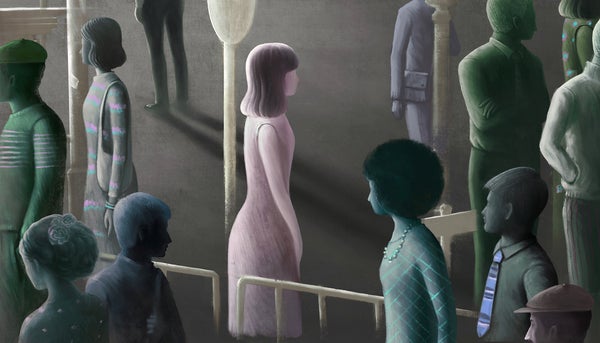“He paid no attention to persons around him. When taken into a room, he completely disregarded the people and instantly went for objects, preferably those that could be spun.” With this memorable description of his first autistic patient in 1943, a five-year boy he called “Donald T.,” child psychiatrist Leo Kanner established a template for viewing people with autism as so disinterested in forging connections with others that they ignore their own parents.
This stereotype of autistic people as essentially solitary—islands unto themselves—has proven remarkably persistent. It lingers in the familiar stock character of the cringeworthy geek like Sheldon Cooper on The Big Bang Theory, and in biographer Walter Issacson’s descriptions of entrepreneur Elon Musk—who claimed to be on the spectrum on Saturday Night Live—as “hardwired” against empathy. Even industrial designer Temple Grandin, the first adult to publicly “come out” as autistic in the 1980s, was portrayed as having little or no interest in friendship and intimacy by neurologist author Oliver Sacks in his profile essay “An Anthropologist on Mars.” He described Grandin as “bewildered” by Romeo and Juliet, Shakespeare’s doomed lovers, because she “never knew what they were up to.”
Now a growing body of research is pushing against that stereotype, finding that many autistic people yearn for human connections and community at least as much as their neurotypical peers. The challenges they face are not attributable solely to their neurology, but also to the ways that nonautistic people respond (or fail to respond) to them. Not surprisingly, intimacy turns out to be a two-way street. The impaired ability of many neurotypicals to accurately gauge the emotional states of people with autism—which Damian Milton, an autistic researcher at the University of Kent, has dubbed the “double empathy problem”—turns out to drive many failures of reciprocity that have long been blamed solely on autistic “impairments.”
On supporting science journalism
If you're enjoying this article, consider supporting our award-winning journalism by subscribing. By purchasing a subscription you are helping to ensure the future of impactful stories about the discoveries and ideas shaping our world today.
A recent study by Rutgers University’s Annabelle Mournet and colleagues concluded that autistic people may be even more powerfully motivated to seek out friendships and community than nonautistic people. These desires are often frustrated by widespread misconceptions about autism, particularly the assumption that people on the spectrum aren’t interested in seeking comfort and support in the company of others. “Autistic adults cannot be assumed to have fewer social connections—or less desire to have social connections,” Mournet wrote in Spectrum. “Our field must work to dismantle these damaging and inaccurate notions.” Dismantling these false notions matters urgently, Mournet points out, because autistic adults are at high risk for suicide, and having a network of supportive connections protects against suicidal ideation.
The tendency of neurotypicals to stigmatize autistic behavior as weird and off-putting also hampers the formation of relationships. This process unfolds subconsciously—even in the first few seconds of interaction, observes Noah Sasson, a psychology professor at the University of Texas at Dallas whose work is deeply informed by the insights of autistic colleagues like Monique Botha. By conducting a study of neurotypicals’ first impressions of autistic people (known in psychology as “thin-slice judgments”), Sasson and his colleagues determined that negative reactions to autistic adults’ atypical body language, facial expressions, tone of voice and frequency of eye contact lead neurotypicals to be less inclined to pursue further interactions. These thin-slice judgments pervasively harm autistic adults’ attempts to find employment, build networks of support and navigate the social landscape in ways that lead to happy, secure and successful lives.
Autistic women, who have often been overlooked altogether in research, face a distinct set of challenges in building friendships, researchers Felicity Sedgewick and Elizabeth Pellicano have found. Struggling to interpret unspoken social signals, and subject to subtle forms of bullying (such as cruel gossip or silent exclusion) by their neurotypical peers, autistic women are uniquely vulnerable to exploitation in romantic and sexual relationships. When difficulties in a relationship arise, they tend to either “assume they are entirely to blame for the problem (and do whatever they can to resolve it) or assume that the friendship cannot be rescued (and so withdraw from the relationship),” Sedgewick and Pellicano observed. “These findings highlight an urgent need for specific and tailored personal safety training and support for autistic women—and, by extension, autistic girls—to ensure that they can enjoy a safe transition to adulthood and positive adult relationships.”
Studies of the roles played by neurotypicals in contributing to the challenges that autistic people face in creating supportive social networks are generally still small and preliminary, but the fact that they’re happening at all is one of the positive outcomes of more autistic people helping to set the agenda for autism research and combating ableist assumptions in study designs. These studies also track the lived experience of autistic people more closely than one-sided theories about social impairments and “mindblindness.”
Kanner’s first autistic patient, whose real name was Donald Triplett, did not remain an island unto himself. He grew up in a small town in Mississippi where he was accepted for who he was. When Triplett died in June, after a happy life of working in a bank, playing golf and traveling the world, his obituary in the New York Timesnoted, “He did have many friends. Some of them, a group of men, joined Mr. Triplett outside Forest’s City Hall for coffee every morning.”
This is an opinion and analysis article, and the views expressed by the author or authors are not necessarily those of Scientific American.
